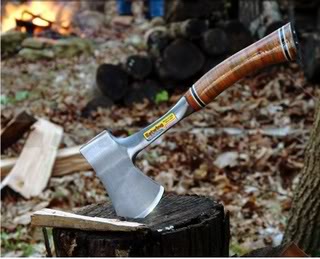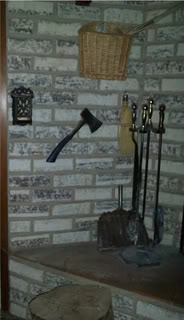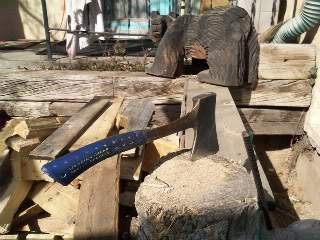Here's a professional artist's portrait of the model Keith just bought:

We used to have a poster of these concepts up on the wall when Kirby was little:
LeverWhen I tried to look up the list, I couldn't find it. I was looking for Greek and tool, but if I'd looked for Renaissance and machine I would have found them.
Wheel and axle
Pulley
Inclined plane
Wedge
Screw
I called Keith to see if he could help. I was saying "incline, wedge, lever," and I said "I think there are six of them."
Keith said "screw," and I said a screw was an inclined plane in a spiral, but he said no, it was separate. So I believed him, kind of, and he told me about an article he had just read about the way the thinking and skills of younger people (tech natives) has changed. We talked about that a while, and then got off the phone.
I googled a bit more and then thought IF I were going to actually get up and look, I wouldn't look for that poster. I don't remember if it was rolled or folded or one of the heavy flat ones from Colborn's, a long-out-of-business educational supply house from which we used to get things like tempera, games, Dover coloring books, and single crayons. So I thought the place to look, in our fairly-vast home library would be an older encyclopedia. Yes! So I went to Wikipedia and found this, as a link from tool: http://en.wikipedia.org/wiki/Simple_machine
So those are not about tools, but about "machines." Yet an axe is a wedge, used all of a sudden.
This is all plenty exciting to me, because I'm easily amused and I love these little hunts and connections, but honestly, the definition of "tool" and the concept has expanded since I was a kid and was told to memorize what a tool was. When I was a kid, humans used tools and that made us human, but that's no longer "the truth." Chimpanzees can use a leaf as a sponge to gather water out of a hole. They will lick a stick and put it down a hole to collect insects (termites? ants? I don't know what). They will move things to climb up on to get something they can't reach.
Marty says he thinks maybe elephants will pick up a stick to knock something down that's higher than their trunks. If they haven't, they should.
So what, these days, are "tools"? My computer? Google? Wikipedia? Blogger.com? My new glasses? That electric teakettle I'm about to go and heat water with?
We talk about parenting tools, and people adding to their toolboxes, and those are all in the realm of thought (and action proceeding from thought, but without physical tools).
I'll add pictures of my own little hatchet/handaxe...


Those are the two places it lives, by the fireplace or near the woodpile for the hot tub. I've had it for twelve years now.
UPDATE, May 7, 2009:
Click the image to see an article Deb Cunefare sent on designer axes:



The link was gone, but there's quite a bit more, now (2022) on designer axes, so I replaced it with a google search.
Humorthis came around by e-mail, from the best man at our wedding nearly 25 years ago, to Keith, to me.Wait... the e-mail didn't come 25 years ago; the wedding did. The e-mail came recently.DRILL PRESS: A tall upright machine useful for suddenly snatching flat metal bar stock out of your hands so that it smacks you in the chest and flings your beer across the room, denting the freshly-painted project which you had carefully set in the corner where nothing could get to it. WIRE WHEEL: Cleans paint off bolts and then throws them somewhere under the workbench with the speed of light. Also removes fingerprints and hard-earned calluses from fingers in about the time it takes you to say, 'Oh sh -- ' ELECTRIC HAND DRILL: Normally used for spinning pop rivets in their holes until you die of old age. SKILL SAW: A portable cutting tool used to make studs too short. PLIERS: Used to round off bolt heads. Sometimes used in the creation of blood-blisters. BELT SANDER: An electric sanding tool commonly used to convert minor touch-up jobs into major refinishing jobs. HACKSAW: One of a family of cutting tools built on the Ouija board principle. It transforms human energy into a crooked, unpredictable motion, and the more you attempt to influence its course, the more dismal your future becomes. VISE-GRIPS: Generally used after pliers to completely round off bolt heads. If nothing else is available, they can also be used to transfer intense welding heat to the palm of your hand. OXYACETYLENE TORCH: Used almost entirely for lighting various flammable objects in your shop on fire. Also handy for igniting the grease inside the wheel hub out of which you want to remove a bearing race. TABLE SAW: A large stationary power tool commonly used to launch wood projectiles for testing wall integrity. HYDRAULIC FLOOR JACK: Used for lowering an automobile to the ground after you have installed your new brake shoes, trapping the jack handle firmly under the bumper. BAND SAW: A large stationary power saw primarily used by most shops to cut good aluminum sheet into smaller pieces that more easily fit into the trash can after you cut on the inside of the line instead of the outside edge. TWO-TON ENGINE HOIST: A tool for testing the maximum tensile strength of everything you forgot to disconnect. PHILLIPS SCREWDRIVER: Normally used to stab the vacuum seals under lids or for opening old-style paper-and-tin oil cans and splashing oil on your shirt; but can also be used, as the name implies, to strip out Phillips screw heads. STRAIGHT SCREWDRIVER: A tool for opening paint cans. Sometimes used to convert common slotted screws into non-removable screws and butchering your palms. PRY BAR: A tool used to crumple the metal surrounding that clip or bracket you needed to remove in order to replace a 50 cent part. HOSE CUTTER: A tool used to make hoses too short. HAMMER: Originally employed as a weapon of war, the hammer nowadays is used as a kind of divining rod to locate the most expensive parts adjacent the object we are trying to hit. UTILITY KNIFE: Used to open and slice through the contents of cardboard cartons delivered to your front door; works particularly well on contents such as seats, vinyl records, liquids in plastic bottles, collector magazines, refund checks, and rubber or plastic parts. Especially useful for slicing work clothes, but only while in use. DAMM-IT TOOL: Any handy tool that you grab and throw across the garage while yelling 'DAMM-IT' at the top of your lungs. It is also, most often, the next tool that you will need. |
No comments:
Post a Comment